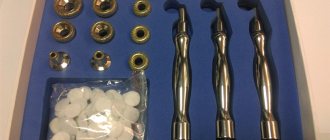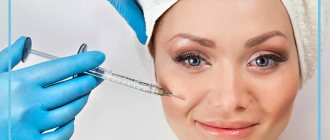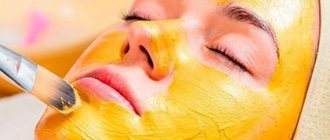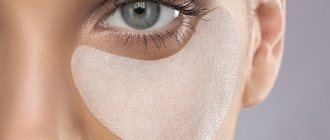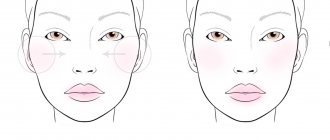Sign up for a free consultation
First of all, let’s define the concept of “achieving an effect,” since in aesthetic medicine, assessing the result of a procedure is a rather subjective concept. When we ask patients the question “What effect do you want to achieve?”, this is not idle curiosity - the answer helps the doctor choose the procedures that are suitable for you.
Both in the case of general answers (“I want to look younger”, “I want my face to tighten”), and with specific requests (“Remove this wrinkle”, “even out the skin in this area”), a specialist will be able to select a course of procedures and solve the problem. But we can only answer the question of how many biorevitalization procedures you will need during an individual consultation, seeing your skin and understanding your needs. On average, the number of procedures in a course is 4-7.
However, you can be sure that the first procedure will give a visual effect. Biorevitalization combines both quick results and long-term effects when undergoing a course of procedures, which is why this technique remains very popular among everyone who cares about their appearance.
Can a course of biorevitalization replace correction with fillers?
At first glance, it may seem that these two techniques are similar. Both procedures are injectable, both are aimed at rejuvenation, and both use preparations based on hyaluronic acid. However, there are many more differences between these procedures, and they cannot be called interchangeable.
The biorevitalization course is aimed at normalizing metabolic processes and moisturizing the deep layers of the skin, restoring its elasticity and turgor. During biorevitalization, the level of hyaluronic acid in the dermis is restored, which results in visible skin rejuvenation, evenness of complexion, elimination of dryness and sagging.
As for contouring using fillers, this is a one-time procedure aimed at correcting a certain area of the face - eliminating ptosis, creases, and deep expression wrinkles. Contour plastic surgery is also used to correct congenital facial asymmetry.
It is possible to choose a procedure that is right for you - biorevitalization, contour plastic surgery or another technique - at a personal consultation with a specialist.
How often do you need to take a biorevitalization course?
Of course, it is possible to give an exact answer to this question only during a personal consultation: after all, everything depends on the condition of your skin. But, in general, we recommend completing a course of procedures 1-2 times a year. This will maintain a constant high level of hyaluronic acid in the dermis, keeping it fresh, elastic and hydrated.
Other schemes are also possible. For example, biorevitalization gives excellent results in the prevention of photoaging, so before and immediately after a vacation in hot countries, we recommend that our patients undergo 1-2 biorevitalization procedures.
Unfortunately, “sun, air and water”, as the famous saying goes, are not your skin’s best friends. Therefore, pre-holiday procedures will saturate the skin with moisture, allow it to react to sun rays, salt water, wind without stress, and prevent uneven pigmentation. And immediately after returning from the sunny paradise, injections of hyaluronic acid will be the best anti-stress remedy for your skin and will allow you to maintain freshness and a healthy appearance for a long time.
In this case, we recommend the next course of biorevitalization no earlier than six months later.
Introduction
The use of contour injection plastic surgery using fillers of various compositions is today one of the most common minimally invasive interventions in aesthetic medicine, second only to the use of botulinum toxin. The main material currently used for these procedures are hyaluronic acid (HA) fillers; their use has been growing steadily over the past 20 years. According to ASPS (American Society of Plastic Surgeons) statistics, the frequency of use of HA fillers increased by more than 2.5 times from 2000 to 2014. The authors’ personal observations from 1998 to 2018 demonstrate even more impressive trends: over 20 years, the number of procedures using HA fillers increased from 193 in 1998 to 1027 in 2022, which represents a more than fivefold increase in the number of contour injection procedures plastics using HA gels (Fig. 1).
Rice. 1. Number of injection contouring procedures using various products.
The history of the use of substances for contour injection facial plastic surgery goes back about 130 years. At the dawn of modern aesthetic medicine, paraffin, fat grafts and silicone were used for procedures. However, the safety and effectiveness of such interventions have not been satisfactory. In the second half of the last century, the first fillers based on bovine collagen (Zyderm, Zyplast) were developed. In the 90s, drugs based on fibrillated Teflon and fibrin were also released. In addition, other collagen derivatives, including human collagen (isolated from the placenta), as well as biopolymers and combined materials, have been marketed at various times. Fillers based on hydroxyapatite and polymers of lactic acid (Poly-L-Lactic Acid - PLLA) have been developed and are used. However, the leading place in the market of drugs for contour injection plastic surgery today is occupied by recombinant HA substances of various modifications [1].
A number of factors have contributed to the spread of HA-based fillers for facial contouring injections. These materials combine a number of advantages that are critical for injection contouring. First, synthetic HA has relatively low immunogenicity. Secondly, despite the limited scientific data on the ratio of the number of adverse events when using different drugs, according to expert estimates, complications with the use of HA fillers are less common. For this reason, the US market is currently dominated by FDA-approved (Food and Drug Administration) drugs based on synthetic HA, the safety of which has been proven in numerous clinical studies [2–4]. Third, HA-based fillers provide significant clinical benefits, such as a long-lasting effect of up to 24 months. depending on the drug, as well as positive results of correction from the patient’s point of view [4]. Despite the faster elimination of HA from the body, fillers based on it provide the most optimal combination of safety and effectiveness for practical use today [5–12].
At the same time, the increased use of HA fillers is associated with an increase in procedure-related adverse events. Thus, in clinical practice in 1998, the authors recorded 3 cases of complications of contour injection plastic surgery with the use of HA, while in 2022 this value was 26, which is an 8-fold increase in the number of adverse events (Fig. 2).
Rice. 2. The number of complications of contour injection plastic surgery when using various fillers. The contribution of various fillers to the overall structure of adverse events associated with their use is presented in Fig. 3.
Rice. 3. The share of various fillers in the structure of complications. For this reason, we decided to conduct a review of modern ideas about the complications associated with the use of HA in facial injection contouring, as well as the tactics of managing patients with various adverse reactions. The article provides information from international expert consensus on complications associated with the use of HA fillers, as well as data from many years of clinical experience of the authors of this article.
Advantages of the method
- The procedure is carried out without significant damage to the skin. Using a needle or cannula, small punctures are made that heal within a couple of days. After such punctures, there are no scars left on the skin;
- Natural result. Small volumes of the drug achieve beautiful and natural results, without weighing down the face, without swelling and long-term rehabilitation. The density of gel fillers is selected individually depending on the characteristics of the body and the area;
- Long lasting effect. Modern fillers slowly dissolve and are eliminated from the body naturally;
- Universal technique. With the help of contour plastic surgery, you can not only straighten wrinkles and make the skin smooth. This procedure is designed to make people more beautiful, correct defects and correct features. When necessary, contour plastic surgery is used by women and men, young and mature - everyone who needs to improve their appearance and be confident in their appearance.
Classification of adverse events
The accumulated practice of using HA-based fillers has led to the emergence of a large number of expert points of view on the classification of complications. This article uses as a basis the classification of adverse events proposed by the expert group F. Urdiales-Galvez et al. [13] in 2018
According to this classification, adverse events can be divided into three large groups according to the timing of occurrence (Table 1).
Table 1. Classification of complications according to the time of their development The diagnosis is made on the basis of histological examination.
Immediate
complications develop within 24 hours after the procedure and include immediate hypersensitivity, vascular complications (embolism, thrombosis, ischemia), subcutaneous hemorrhages of varying severity (hematoma), pain at the injection site, local swelling and erythema, reactivation of herpetic infection and paresthesia.
To the early
, developing in the period from 24 hours to 4 weeks. after the procedure, the following undesirable reactions include: hypercorrection and displacement of the filler, hematoma, infectious complications (reactivation of herpetic infection, skin and soft tissue infections), hypersensitivity reactions, impaired muscle function, Tyndall effect, paresthesia, prosopalgia (pain in the facial area).
Deferred
complications develop later than 4 weeks. from the moment of the procedure and include nodules (single, multiple), having both non-inflammatory and inflammatory nature, as well as granulomas, infectious complications, including skin and soft tissue infections, atypical infections (biofilms), bacteremia, dyschromia, neovascularization, reactions hypersensitivity, filler displacement, Tyndall effect, edema, including persistent.
Further consideration of adverse events associated with the use of HA fillers will occur in accordance with the presented classification.
The direct occurrence of adverse events is most often associated with the characteristics of the drug or errors in its use by a specialist.
The rest of the article discusses complications in accordance with the presented classification. It is worth noting that due to the possibility of the development of early adverse events both within immediate and during periods corresponding to delayed complications, their consideration is carried out outside a separate group in the text of the article in order to avoid duplication of information.
Biorevitalization course price
| Area of influence / List of procedures | Price |
| JALUPRO | 7 000 |
| VISCODERM 0.8% | 8 500 |
| VISCODERM 2.0% | 9 500 |
| TEOSYAL MESO | 10 500 |
| IAL SYSTEM | 12 000 |
| JUVEDERM HYDRATE | 13 500 |
| RESTYLANE VITAL | 14 000 |
| IAL SYSTEM ACP | 16 500 |
| MESO−XANTHIN F199 | 18500 |
| MESO-WHARTON P199 | 18500 |
* — price is indicated in rubles
Purchase a gift certificate for the procedure
Go to the BIOREVITALIZATION
Similar:
- Laser biorevitalization
In press:
- Basic procedure to maintain youthful skin
News:
- A new method of hardware cosmetology – a procedure for laser biorevitalization of the skin
Immediate and early adverse events
As stated earlier, immediate adverse events develop within 24 hours after the procedure, early ones - in the period from 24 hours to 4 weeks. All complications of this group can be divided into two conditional subgroups:
- common (reactions at the injection site);
- actual adverse events associated with the procedure.
Local reactions to injection occur in connection with the procedure itself, which involves a traumatic effect on the tissue of the needle or cannula. In addition, the administration of the drug promotes tissue displacement, provoking these temporary reactions. This group of adverse events includes the following manifestations.
Hemorrhages
occur due to damage to small blood vessels along the movement of the needle or cannula; in addition, their appearance is associated with rupture of capillaries at the site of gel injection and increased vascular permeability due to the influence of the drug components [14]. According to the literature [15], hemorrhages more often develop with subcutaneous injection of material using the fan and linear technique than with supraperiosteal injection.
Hemorrhages can have different distributions: petechiae, ecchymoses, hemorrhagic impregnation and hematoma. Local reactions include only petechiae and ecchymosis. Clinically, the presence of blood under the skin is manifested by a change in the color of the skin at the injection site from purple to yellow-green. The dynamics are characterized by the evolution of hemorrhage with a change in color to yellow as the phenomenon resolves (blooming phenomenon). Clinical examples are presented in Fig. 4.
Rice. 4. Ecchymosis at the site of drug administration.
Clinical diagnosis of this adverse reaction boils down to a physical examination and is not difficult for specialists. If necessary, an ultrasound method and a clinical blood test can be used.
Minor hemorrhages (petechiae and ecchymoses) do not require mandatory therapy and resolve on their own within 7-10 days. In some cases, it is recommended to apply heparin ointment, gels containing arnica extracts (Traumeel S) 2-3 times a day to speed up healing. It is also possible to use fractional photothermolysis, which, however, will lead to a decrease in the volume of the administered drug. According to some data [16], pressure on the injection area reduces the risk of local hemorrhages.
Edema and erythema
also refer to typical reactions associated with the injection of fillers and arise due to compression of the capillaries draining the blood, injury and displacement of the tissues surrounding the drug, as well as the ability of HA to retain water for some time. These adverse reactions are manifested by hyperemia and swelling at the injection site (Fig. 5);
Rice.
5. Erythema at the injection site. their diagnosis is not difficult and is carried out clinically. Local cooling of the tissues immediately after the procedure helps reduce the severity of these phenomena. Erythema most often resolves on its own within a few hours, sometimes up to 7 days. Swelling may persist for up to 2 weeks. in some cases. Soreness
at the injection site is associated with compression of nerve endings by the drug and surrounding edematous tissues. The pain resolves on its own with a decrease in the severity of swelling and can sometimes bother the patient for up to 7 days.
Complications directly related to the injection of fillers require special attention and vigilance due to possible consequences. This group of immediate adverse events includes:
- hematoma;
- immediate hypersensitivity;
- reactivation of herpetic infection;
- vascular complications.
Hematoma
is a cavity filled with blood from a damaged vessel. This complication develops more often with deep injection of fillers than with superficial placement of the drug. Clinically manifested as swelling and hardening of soft tissues (fibrin clot), accompanied by moderate pain, possible signs of neuropathy and discoloration of the skin (Fig. 6).
Rice.
6. Hematoma at the injection site. Swelling and slight redness of the skin are visualized. The diagnosis of hematoma is made clinically by detecting the indicated signs and symptoms in the patient; ultrasound diagnostic methods can be used for confirmation (Fig. 7),
Rice. 7. Hematoma on ultrasound. A cavity in the soft tissues with echogenicity of blood is determined. MRI visualizing a cavity with blood-density fluid.
Often, the hematoma resolves on its own, but the risk of developing bacterial complications during its lysis remains high. For this reason, careful monitoring of the dynamics of the clinical picture is recommended as therapeutic measures. On the 6-7th day after the development of an undesirable phenomenon, lysis of the contents of the cavity begins, it becomes more liquid. To prevent purulent complications, it is recommended to puncture the hematoma during this period, followed by antibiotic therapy. In addition, it may be recommended to use hyaluronidase drugs (Longidase 1500-3000 IU at the site of filler injection once, repeat the injection if necessary) to reduce the volume of filler and accelerate the healing of the hematoma.
Immediate hypersensitivity reactions (IHT).
Allergic reactions are rare complications associated with the use of fillers. HA-based drugs are considered the safest in this regard [17]. At the same time, due to the presence of impurities associated with the synthesis of GC, the risk of developing immediate hypersensitivity increases significantly [18].
Clinically, reactions mediated by immunoglobulin E can manifest as local signs in the form of swelling, itching and hyperemia (Fig. 8),
Rice. 8. Erythema and swelling during an allergic reaction. and generalized (symptoms of anaphylaxis, Quincke's edema). In case of local reactions, it is recommended to use antihistamines for 3-5 days, it is possible to prescribe ointments with corticosteroids (hydrocortisone, applied locally 2-3 times a day) and the use of gyaulronidase (Longidase 1500-3000 IU at the site of filler injection once, repeat if necessary introduction). Generalized reactions require emergency treatment with the administration of glucocorticosteroids (prednisolone 30-90 mg intravenously, maximum daily dose 90 mg) [16].
Reactivation of herpes infection
occurs due to insufficient medical history or the patient’s concealment of information about his health. As is known, the prevalence of herpes virus type 1 (labial) in the population is up to 98%, however, not all patients receiving contour injection procedures have a risk of reactivation of the infection. More often, herpetic infections occur against the background of a subsiding or beginning exacerbation. The initial clinical manifestations include tingling, itching in the area of injection (usually perioral, less often on the nasal mucosa or hard palate); then the classic picture develops with papules evolving into vesicles, which subsequently open to form crusts. In the presence of filler, manifestations may be more pronounced; in addition, the formation of abscesses and purulent complications is possible (Fig. 9)
Rice.
9. Picture of reactivation of herpes labialis (swelling, erythema, vesicles). [19, 20]. In case of suspicion of the possibility of reactivation of a herpetic infection, it is recommended to prescribe short courses of antiherpetic drugs: acyclovir (Zovirax) 200 mg 5 times a day for 5-7 days of use, valacyclovir (Valtrex) 500 mg 2 times a day for 5 days, famciclovir (Famvir ) 1.0 g 2 times for 1 day. Specific diagnostics, as a rule, are not required; the diagnosis is made clinically. When an active infection develops, antiviral drugs are also prescribed (locally and systemically), most often requiring hospitalization of the patient [13]. Vascular complications
are often not divided into groups, but may have different pathophysiology, and therefore these adverse reactions are classified into occlusive and compression-ischemic syndromes. The main causes of vascular complications are considered to be medical errors, as well as the anatomical features of the patient’s blood vessels.
Occlusion develops as a result of damage to the vessel with a needle and the introduction of filler into its lumen, and is characterized by immediate development with the appearance of pain “at the end of the needle”, rapidly increasing swelling and blanching of the skin in the area where the drug was administered. In addition, vision impairment, including loss of vision, and stroke are possible. Occlusion of the angular artery can be fatal. Visual symptoms and acute cerebrovascular accident, according to some data, develop due to the ability of fillers to retrograde flow and pass through multiple arterial anastomoses, more often associated with injections in the upper third of the face [21]. It is believed that strokes develop due to gel entering the supratrochlear artery ( a
.
supratrochlearis
), which has anastomoses with the internal carotid artery through the ophthalmic artery (
a
.
ophthalmica
).
Compression-ischemic syndrome occurs when a vessel is compressed by filler without mechanical damage. Symptoms may develop over 24 hours and include slowly increasing swelling, local tenderness, and increased vascularity. Clinical signs of vascular complications are presented in Fig. 10.
Rice. 10. Occlusion of vessels of various locations.
Diagnosis is carried out clinically; ultrasound can be used to confirm and clarify.
In the development of vascular complications, there are several pathophysiological stages of tissue circulatory disorders: paranecrosis (initial processes of circulatory disorders, reversible), necrobiosis (irreversible disorders of tissue metabolism), apoptosis (programmed cell death), autolysis (cleansing of the lesion from dead tissue by cells of the immune system) (see Fig. 11).
Rice. 11. Pathophysiological stages of tissue circulatory disorders. Treatment is different at each sequential stage, and early intervention is directly associated with favorable outcomes.
Therapy should be started immediately when symptoms of paranecrosis are detected with the administration of Longidase by wide injection of the lesion up to 3000 units, the administration is continued over the next day, the maximum dose is up to 15,000 units [22]. In the future, with the development of necrobiosis, it is recommended to use anticoagulant therapy: low molecular weight heparins (Clexan 8000 IU/day) and antiplatelet agents (acetylsalicylic acid 125 mg/day, clopidogrel 75 mg/day). Clinical experience shows that the use of sprays and ointments with nitroglycerin can be effective (contraindicated in the perioral area due to the risk of systemic effects and the development of hypotension) and vascular agents (pentoxifylline (Trental) 400 mg/day intravenously), continued administration of hyaluronidase (Longidase). If the process progresses to apoptosis, antibacterial agents are added to therapy (ciprofloxacin (Tsiprobay) 1000 mg/day), Actovegin (800-1200 mg intravenously daily for up to 4 weeks). At the autolysis stage, it is possible to use physiotherapeutic methods to accelerate tissue healing (fractional photothermolysis, etc.).
In order to prevent the development of vascular complications, a number of measures must be observed. Proper knowledge of the topographic anatomy of the face and possible individual characteristics has a significant impact on reducing the risk of developing such complications. When selecting the injection site, consideration must be given to hazardous areas. It is recommended to use an aspiration test before injection. The use of thin and short needles and cannulas leads to a lower risk of perforation of the arterial wall.
In recent decades, the incidence of neurological complications
after filler injections. Most often, neuropathic disorders develop as a result of damage to the nerve with a needle, injection of filler into it, or compression of the nerve ending with gel. Nerve damage can be either transient or irreversible in some cases. Sensory, motor and mixed disorders are possible. The most commonly affected nerve is the infraorbital nerve.
Disorders of the function of the facial (Bell's palsy) and mandibular nerves are much less common, but these disorders can be persistent and last up to several weeks [19, 20, 23, 24]. The time for the development of adverse events varies from the effect at the end of the needle to a day or even several days.
Clinical manifestations include neuropathic (high-intensity) pain, allodynia, anesthesia, hypoesthesia and hyperesthesia, dysesthesia, paresthesia (feelings of goosebumps, tingling, cold and heat in the absence of an external stimulus), decreased muscle tone, increased tone of antagonist muscles. Examples from the author's practice are presented in Fig. 12.
Rice. 12. Motor neurological disorders.
The diagnosis is made clinically, taking into account data from magnetic resonance imaging and electromyography (Fig. 13).
Rice. 13. The use of MRI in the diagnosis of neurological complications of contour injection facial plastic surgery.
Treatment consists of a complex of interventions. It is proposed to use α-lipoic acid preparations (Berlition 300 mg per day for 2-4 weeks, Thioctacid 600 mg once a day for 2-4 weeks) intravenously, followed by transfer to oral administration for 1-3 months. It is recommended to use neurovitamins (Neurobion 2 tablets per day for 10 days, Milgamma 2 tablets per day for up to 4 weeks) and venotonics (Detralex 2 tablets per day for 4 weeks, Phlebodia 1 tablet per day for up to 2 months). Symptomatic treatment of neuropathic pain is carried out with the use of amitriptyline. It is also possible to use short courses of high doses of corticosteroids (prednisolone 1 mg/kg orally for up to 5 days) [25]. Some experts suggest the use of physiotherapy and acupuncture, but the effectiveness of these interventions for neurological disorders is questionable. In addition, the authors recommend the use of botulinum toxin to reduce the tone of antagonist muscles in the area of motor nerve damage.
